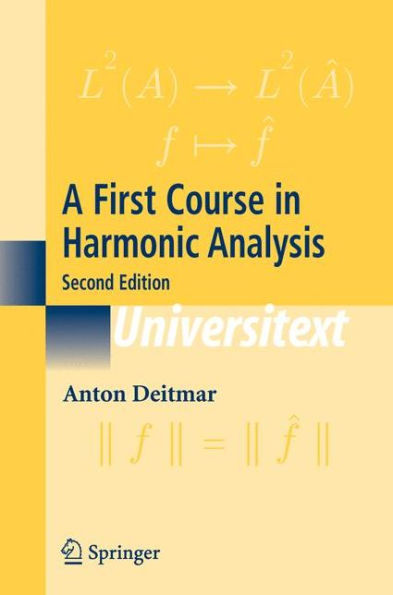A First Course in Harmonic Analysis
The second part of the book concludes with Plancherel’s theorem in Chapter 8. This theorem is a generalization of the completeness of the Fourier series, as well as of Plancherel’s theorem for the real line. The third part of the book is intended to provide the reader with a first impression of the world of non-commutative harmonic analysis. Chapter 9 introduces methods that are used in the analysis of matrix groups, such as the theory of the exponential series and Lie algebras. These methods are then applied in Chapter 10 to arrive at a clas-—cation of the representations of the group SU(2). In Chapter 11 we give the Peter-Weyl theorem, which generalizes the completeness of the Fourier series in the context of compact non-commutative groups and gives a decomposition of the regular representation as a direct sum of irreducibles. The theory of non-compact non-commutative groups is represented by the example of the Heisenberg group in Chapter 12. The regular representation in general decomposes as a direct integral rather than a direct sum. For the Heisenberg group this decomposition is given explicitly. Acknowledgements: I thank Robert Burckel and Alexander Schmidt for their most useful comments on this book. I also thank Moshe Adrian, Mark Pavey, Jose Carlos Santos, and Masamichi Takesaki for pointing out errors in the first edition. Exeter, June 2004 Anton Deitmar LEITFADEN vii Leitfaden 1 2 3 5 4 6
1100746926
A First Course in Harmonic Analysis
The second part of the book concludes with Plancherel’s theorem in Chapter 8. This theorem is a generalization of the completeness of the Fourier series, as well as of Plancherel’s theorem for the real line. The third part of the book is intended to provide the reader with a first impression of the world of non-commutative harmonic analysis. Chapter 9 introduces methods that are used in the analysis of matrix groups, such as the theory of the exponential series and Lie algebras. These methods are then applied in Chapter 10 to arrive at a clas-—cation of the representations of the group SU(2). In Chapter 11 we give the Peter-Weyl theorem, which generalizes the completeness of the Fourier series in the context of compact non-commutative groups and gives a decomposition of the regular representation as a direct sum of irreducibles. The theory of non-compact non-commutative groups is represented by the example of the Heisenberg group in Chapter 12. The regular representation in general decomposes as a direct integral rather than a direct sum. For the Heisenberg group this decomposition is given explicitly. Acknowledgements: I thank Robert Burckel and Alexander Schmidt for their most useful comments on this book. I also thank Moshe Adrian, Mark Pavey, Jose Carlos Santos, and Masamichi Takesaki for pointing out errors in the first edition. Exeter, June 2004 Anton Deitmar LEITFADEN vii Leitfaden 1 2 3 5 4 6
79.99
In Stock
5
1

A First Course in Harmonic Analysis
192
A First Course in Harmonic Analysis
192Paperback(Second Edition 2005)
$79.99
79.99
In Stock

Product Details
| ISBN-13: | 9780387228372 |
|---|---|
| Publisher: | Springer New York |
| Publication date: | 03/09/2005 |
| Series: | Universitext |
| Edition description: | Second Edition 2005 |
| Pages: | 192 |
| Product dimensions: | 6.10(w) x 9.25(h) x 0.02(d) |
About the Author
From the B&N Reads Blog
